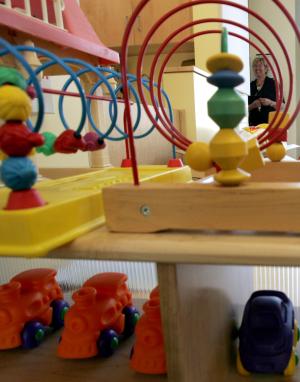 Caption: Betsy Gibbs peeks through a child's toy. Photo by Karen Tapia
Caption: Betsy Gibbs peeks through a child's toy. Photo by Karen Tapia
About Childcare
Center Director Betsy Gibbs Promotes Early Learning
ON HER OFFICE DOOR at the Children’s Center, a quote by Sitting Bull appropriately reflects Betsy Gibbs’ years of work: “Let us put our minds together and see what lives we will make for our children.”
For the past 37 years as director of the center, Gibbs has worked to offer children — and their student parents — the best possible care, and now, a new facility where children can continue to learn, grow and explore.
Gibbs has been a driving force behind the new $8.7 million Children’s Center, a program of Associated Students, Inc., which opened in January.
The new children’s complex consists of three separate classroom buildings, indoor and outdoor play areas, kitchenettes, and more.
The center is licensed for 122 children, which means that the center now can care for about 180 children, infants to pre-kindergarten-age, accommodating about 35 percent more children than the former center, Gibbs said. The center primarily serves university student parents and their young children, as well as children of faculty and staff members.
A staff of eight master teachers, a cook and maintenance and administrative staff, oversee the center’s daily operations. To help in the classrooms, the kitchen and offices, the center also has 60 student assistants, many of whom are studying early childhood development, as well as 25 student interns. She recently answered a few questions about the center and its mission.
Why was a new center needed?
In 1971, a student parent needed care for her 4-year-old, and so the program was born. However, for several years, childcare was provided off campus. Since 1979, the Children’s Center operated in temporary buildings on campus, but a permanent facility designed for the purpose of early childhood care and education was sorely needed. Over the years, the Children’s Center has also had many student families on a waiting list, indicating that a larger facility was needed. Since 2001, the university expressed interest in childcare for faculty and staff children as well, thus increasing the scope of the new facility. In April 2003, a committee made up of Associated Students Inc., facility and planning staff and child development faculty began meeting to create the new center concept. In November 2009, construction began on our new center.
What does having a new center mean to you?
We need to thank the vision of the students, who voted in 1996 to raise the funds for this new building, and to subsequent students who have maintained a high level of support for the childcare program. I also want to acknowledge the teachers who, over the years, have built a program that sparkles and sings, despite the limited environment of our old center. Teachers are the ones who are making the difference in the lives of the children, and I am gratified to see that they now have a permanent place that supports their fine work.
How will the new center better serve student families and their children?
For optimal group care and learning, the environment for young children needs to be thoughtfully designed — and in our new center, we incorporated many details that benefit the children. For example, outdoor play is essential, and direct access to yards is greatly preferred over trips down a long hallway. So, all of our classrooms have easy access to play yards. Also, indoors, the new classrooms have 40 percent more space for learning centers, and the restrooms can be more easily accessed and supervised. For student parents, we also have a study area for their academic work, as well as educational resources.
What are some of the center highlights?
The new space is aesthetically rich and peaceful with a seamless connection between the landscape and the indoor spaces. In the yard areas, children ages 2 and older have wonderful water play incorporated into their sandboxes. The yards are full of natural elements, safe surfacing and opportunities for climbing, gardening, socializing and riding cycle toys. Each classroom has direct access to a kitchenette, and anyone who has spent time with young children realizes that food and cleanup are constantly needed!
What is your vision for the center?
The Children’s Center is a place that humanizes the very large environment of the campus; it’s a place where several generations interact around common interests. Student parents have a chance to meet each other and share common concerns and joys about parenthood with each other and with faculty and staff parents. The student assistants also have a place to connect meaningfully with other students while learning new skills, and to provide an important service to others while contributing to the development of the center as a whole. Overall, I believe that this center has a unique approach to working with young children, and that the foundation that we have built over the years can have a lasting effect in the lives of the children, as well as for the student assistants.
February 22, 2011
